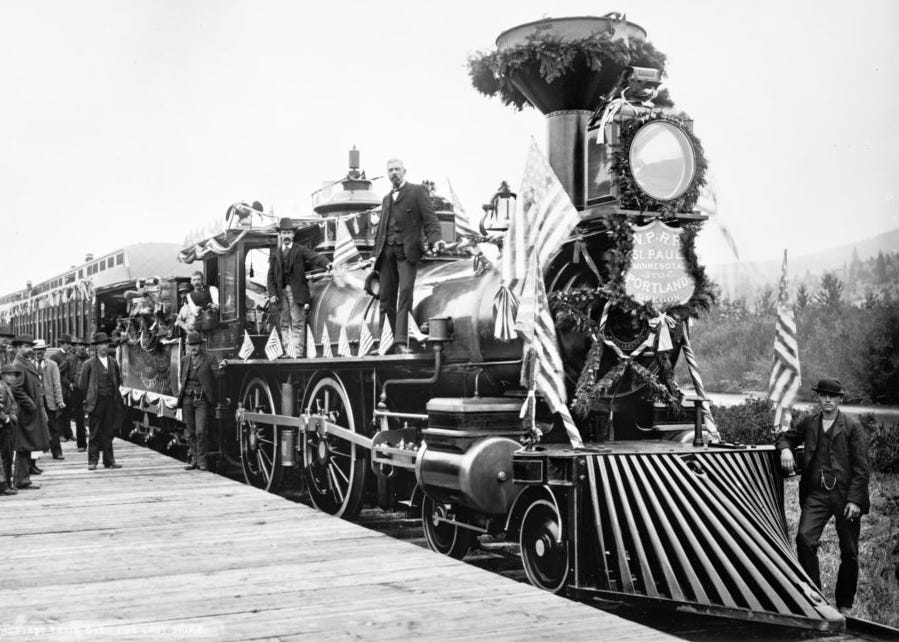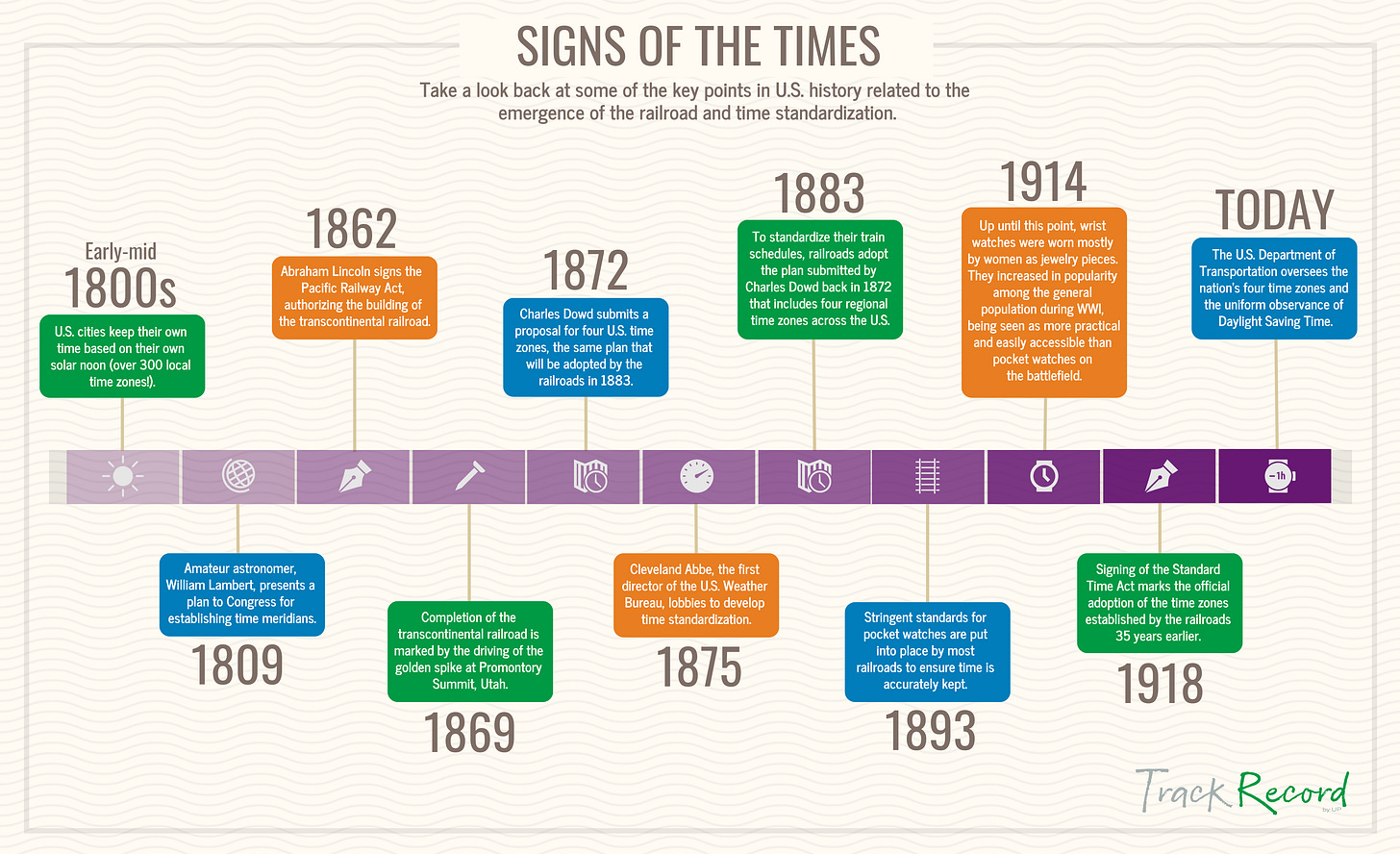November 18 - Mastering Time: The Great Railroad Innovation of 1883
Divine Order: From Chaos to God's Purpose
This is the day American and Canadian railroads established standardized time zones across North America in 1883.
In today's lesson, we explore how a revolutionary change in timekeeping reflects God's transformative work in our lives. Through the lens of the standardization of time zones, we discover profound truths about divine order, human resistance to change, and the beauty of surrendering to God's perfect timing. What areas of chaos in your life might God be waiting to transform?
"But everything should be done in a fitting and orderly way." - 1 Corinthians 14:40 (NIV)
This Date in History
At precisely noon on Sunday, November 18, 1883, thousands of railroad workers across North America stood poised with their pocket watches, waiting for the telegraph signal that would synchronize time across the continent. In what newspapers dubbed "The Day of Two Noons," Americans experienced an unprecedented moment - some watched as their clocks turned backward, living through the same hour twice, while others jumped forward, quite literally losing time. This remarkable day marked humanity's first large-scale attempt to standardize time itself.
Before this revolutionary change, time in North America existed as a patchwork of local standards, each community setting its clocks by the sun's position. Town clockmakers would calculate local noon when the sun reached its highest point in the sky, and every other hour was measured from that moment. This meant that neighboring towns mere miles apart could differ by several minutes. A merchant traveling just 12 miles east or west would need to adjust their watch by roughly one minute to match the local time.
This system had functioned adequately in an agrarian society, where most people rarely traveled far from home. However, the rapid expansion of railroads in the mid-19th century exposed its impracticality. Railroad companies faced a logistical nightmare - with over 300 local time standards across the United States, creating accurate train schedules proved nearly impossible. A train might arrive at a station when its schedule showed 4:00 PM, only to find the local time was 4:23 PM. This confusion led to numerous accidents, including several fatal collisions when trains found themselves on the same track at unexpected times.
William F. Allen, secretary of the General Time Convention of the railroads, spent years studying this problem. He collaborated with Charles F. Dowd, a school principal who had first proposed dividing the country into time zones in 1870. Allen refined Dowd's concept, eventually developing a plan that divided the continent into four distinct time zones, each exactly one hour apart. He chose the 75th, 90th, 105th, and 120th meridians as the centers of these zones, with boundaries adjusted to accommodate major cities and railroad terminals.
The adoption of standard time zones represented a remarkable feat of coordination in an era before instant mass communication. Railroad companies, then among the most powerful corporations in America, implemented the change without waiting for government approval. Major cities gradually followed suit, though some initially resisted. San Francisco's city council denounced the change as an attempt by railroad barons to usurp local authority. Detroit stubbornly maintained local time until 1900, when its city council finally conceded to the practical necessity of standardization.
The success of North America's time zone system sparked a global transformation. Britain, which had already adopted a standard time based on the Greenwich meridian in 1847, helped lead the push for international standardization. In 1884, delegates from 27 nations gathered at the International Meridian Conference in Washington, D.C., where they established Greenwich as the prime meridian and divided the world into 24 time zones. Though some nations initially resisted - China didn't adopt the system until 1949 - Allen's pioneering work in North America had demonstrated the practical necessity of standardized time in an increasingly interconnected world.
This standardization fundamentally altered humanity's relationship with time. For the first time, time became something governed by human systems rather than solely by nature. The pocket watch replaced the sundial as the ultimate authority, and synchronized time became the heartbeat of modern industrial society.
Historical Context
The 1880s marked the zenith of America's Gilded Age, a period of unprecedented industrial growth and technological innovation. Railroad companies wielded enormous economic and political power, controlling not just transportation but also vast swaths of land granted by the government. Their influence extended into every aspect of American life, from commerce to politics, making them uniquely positioned to implement sweeping changes like time standardization.
Telegraph lines paralleled railroad tracks across the continent, creating the first nationwide communications network. This revolutionary technology had already transformed how people communicated and conducted business, making the coordination of standardized time technically feasible. The telegraph system, operated largely by Western Union, served as the backbone for transmitting precise time signals across the country, enabling the synchronization of thousands of clocks simultaneously.
The late 19th century witnessed a broader movement toward standardization across many aspects of American life. The metric system gained advocates, though it wouldn't be widely adopted. The National Bureau of Standards was established to create uniform weights and measures. Cities standardized everything from fire hydrant fittings to screw threads. This push for standardization reflected a society transitioning from local, independent communities to an interconnected industrial nation.
America's rapid urbanization during this period created new demands for precision in daily life. Factory whistles regulated work schedules, and urban workers increasingly needed to coordinate their movements with mechanical timepieces rather than the sun. The adoption of standard time zones represented just one aspect of this larger transformation from natural to mechanical time-keeping, from agricultural to industrial rhythms of life.
Did You Know?
Before standardization, some American cities had multiple time standards operating simultaneously - railroad time, local sun time, and in some cases, a compromise "city time."
Today’s Reflection
In an age where seconds are digitally synchronized and every moment accounted for, it's easy to forget that time itself once flowed with fractured rhythms across North America. Before the introduction of standardized time zones in 1883, each town kept its own unique time, creating a patchwork of hours and minutes that shifted unpredictably with every passing mile. The result was a chaotic system where schedules clashed, confusion reigned, and coordination was all but impossible.
This chaos mirrors a profound spiritual truth: God's original creation was marked by divine order, a perfect rhythm established by the Creator. In the beginning, all things operated in harmony with His will and purpose. Genesis 1 shows us this beautifully—God spoke order into formlessness, bringing light into darkness and establishing boundaries and structure. His design reflected His character: precise, life-giving, and whole.
But just as the pre-standardized time system eventually unraveled into confusion, humanity's rebellion introduced disorder into God's creation. Sin shattered the divine order, leading to brokenness, separation, and a fractured existence. The world became like scattered timepieces, each following its own course, resulting in spiritual chaos. We see this reflected not only in our fallen world but also within our own hearts—torn between conflicting desires, prone to disarray, and resistant to God's ordering hand.
When American and Canadian railroads recognized the need for a unified system to prevent calamity, they acted decisively to impose order on the chaos. Similarly, God offers His divine order to a world plagued by sin's disruption. His call is not one of mere regulation but of redemptive transformation—a restoring of what was broken and scattered. "But everything should be done in a fitting and orderly way," reminds us that God's order is purposeful, bringing life, peace, and meaning to those who embrace it 1 Corinthians 14:40 (NIV).
Resistance to standardized time zones was fierce at first. Many communities clung to their local rhythms, unwilling to adjust to a new, coordinated system. In our own lives, we often resist God's ordering work, preferring the familiar chaos of self-rule to the challenge of submission. This resistance is deeply rooted in pride and the desire for control, but it ultimately leads to spiritual exhaustion and missed opportunities for growth and peace.
Consider how the railroads required precise coordination, trust, and submission to a unified schedule. Likewise, God calls us to trust His timing and His ways, even when they challenge our plans. Ecclesiastes 3:11 (NIV) reminds us, "He has made everything beautiful in its time." This beauty is not found in haphazard chance but in the steady hand of a Creator who transforms our chaos into a masterpiece of divine order.
God's work in our lives does not eliminate our uniqueness or erase our individual character. Just as communities retained their distinctiveness within the framework of standardized time, we, too, flourish within God's redemptive order. He shapes and directs us, not to make us identical, but to make us whole—reflecting His glory and purpose.
The establishment of standardized time zones was more than a logistical fix; it symbolized humanity's capacity to bring structure for the greater good. When we submit to God's order, we enter into a similar work—allowing His Spirit to bring peace to our chaos, purpose to our days, and wholeness to our fractured hearts. His divine order is not restrictive but liberating, offering a path from the disorder of sin to the fullness of life in Christ.
Practical Application
Take time to identify one area of your life where resistance to God's ordering work has created ongoing chaos or discord. Write down specific ways this resistance manifests - perhaps in time management, relationships, or spiritual disciplines. Then, choose one small, concrete step toward surrendering this area to God's authority. Rather than attempting sweeping changes, focus on this single point of surrender, allowing God's ordering work to begin transforming chaos into His divine purpose.
Closing Prayer
Sovereign Lord, we confess our tendency to cling to the familiar chaos of our own making rather than submit to Your perfect order. Thank You for Your patient work in bringing light to our darkness and structure to our scattered lives. Help us recognize the areas where we resist Your transformative touch, and grant us the courage to surrender these spaces to Your wisdom and authority. Shape us according to Your divine purpose, not to restrict us, but to free us for the full life You intend. In Jesus' name, Amen.
Supplementary Study
"For since the creation of the world God's invisible qualities—his eternal power and divine nature—have been clearly seen, being understood from what has been made, so that people are without excuse."
Even in human attempts to bring order from chaos, like the standardization of time zones, we see reflections of God's divine nature and His ordering work in creation.
"He is before all things, and in him all things hold together."
Just as standardized time zones created a framework that held railway schedules together, Christ provides the ultimate framework that holds all of creation in divine order.
"It is I who made the earth and created mankind on it. My own hands stretched out the heavens; I marshaled their starry hosts."
This verse reinforces God's role as the ultimate creator and organizer of the universe, demonstrating His authority over all creation and His perfect ordering of the cosmos.
Final Thoughts
The transformation from scattered local times to standardized zones offers a powerful metaphor for God's redemptive work in our lives. Just as this change required trust, submission, and a vision of something greater than individual preferences, our spiritual transformation demands similar courage and surrender. When we allow God's ordering hand to work in our lives, what once was chaos becomes a testament to His divine purpose and perfect timing.
Community Engagement
Share your thoughts or use these questions to get the conversation started.
What challenges do you think communities faced when adjusting to standardized time zones?
In what areas of your life do you find yourself most resistant to God's ordering work?
How has experiencing God's transformation of chaos to order in your life helped you trust Him in other areas?
What role does pride play in our resistance to divine order, and how can we overcome it?
This devotional is free to read. You can support this publication by becoming a subscriber, upgrading to paid subscriber status, liking (❤️) this post, commenting, and/or sharing this post with anyone who might enjoy it.
In tomorrow's lesson, we'll explore how one of America's largest corporations learned an expensive lesson about the dangers of believing their own hype. Through this fascinating business failure, we'll discover timeless truths about the empty promises of worldly success and the path to genuine fulfillment.
Bonus - Did You Know?
During the transition to standardized time, jewelers and watchmakers played a crucial role as "time custodians," maintaining precise chronometers that were synchronized via telegraph with the U.S. Naval Observatory.
Charles F. Dowd initially proposed dividing the country into hour-wide time zones while running a girls' school in Saratoga Springs, New York, after his students questioned why train schedules were so confusing.
The implementation of standard time zones was technically voluntary - the U.S. Congress didn't officially adopt the system until the Standard Time Act of 1918, 35 years after the railroads implemented it.
William F. Allen's original proposal included a fifth time zone for eastern Maine, but this was ultimately rejected as impractical.
The development of accurate marine chronometers for navigation at sea in the 18th century laid the groundwork for precise time standardization on land.
The term "railroad time" became synonymous with precision and reliability in the late 19th century, giving rise to the phrase "running like clockwork."
Additional Resources
Mapping Time: The Calendar and Its History - E.G. Richards
Keeping Watch: A History of American Time - Michael O'Malley
Standard Time: Its History and Use - William E. Knowles Middleton
Railroaded: The Transcontinentals and the Making of Modern America - Richard White









I guess that was the reason everyone used to complain about the trains being "always late" or "always early" .
Sin shattered the divine order-boom! This one stands out in the gold nugget of truth bombs and when you add in the knowledge of how time zones were created-Brilliant! Outstanding read my friend!